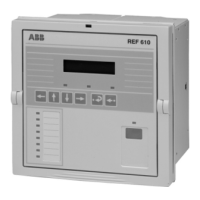23
The pulse length of the digital input signal does not affect time
synchronization.
If time synchronization messages are received from a communication
protocol as well, they have to be synchronized within ±0.5 minutes at
minute-pulse or ±0.5 seconds at second-pulse synchronization.
Otherwise the time difference may appear as rounding errors. If it is
possible that the synchronization messages from the communication
protocol are delayed more than 0.5 seconds, minute-pulse
synchronization must be used.
When the minute-pulse synchronization is active and long time format
is sent via a communication protocol, the protocol's second and
millisecond part is ignored. The protocol's minute part is rounded to
the nearest minute. Short time format is ignored altogether.
When the second-pulse synchronization is active and long or short time
format is sent via a communication protocol, the protocol's millisecond
part is ignored. The protocol's second-part is rounded to the nearest
second.
5.1.2. Measurements
The table below presents the measured values which can be accessed through the
HMI.
Table 5.1.2.-1 Measured values
Indicator Description
L1 Current measured on phase L1
L2 Current measured on phase L2
L3 Current measured on phase L3
I
0
Measured earth-fault current
ΔI Calculated phase unbalance
θ Calculated thermal level
I
1 minute
The average current of the three phase-to-
phase currents during one minute
I
n minute
The average current of the three phase-to-
phase currents during the specified time range
Max I The maximum of one-minute average current of
the I n_min
5.1.3. Configuration
The Fig. 5.1.3.-1 illustrates how the internal and digital input signals can be
configured to obtain the required protection functionality.
Feeder Protection Relay
Technical Reference Manual
REF 610REF 610
1MRS755310

